The Numerical Study on Indoor Heat and Moisture Transfer Characteristics of an Ancient Palace Building in Beijing
Abstract
1. Introduction
2. Indoor and Outdoor Heat and Humidity Environment Testing of Ancient Buildings
2.1. Overview of Ancient Buildings
2.2. Outdoor Environmental Parameters
2.3. Indoor Environmental Parameters
2.4. Indoor Flooring Parameters
3. Numerical Simulation
3.1. Physical Model
3.2. Mathematical Model
3.2.1. Basic Assumptions
- (1)
- The soil and the wall are wet sources;
- (2)
- The ground and the wall are the water vapor flow inlet, and the two windows are the gas outlets;
- (3)
- The building interior is natural convection, and the indoor airflow is a low-speed flow, which is regarded as an incompressible fluid [26], and satisfies the ideal gas equation of state;
- (4)
- The water vapor mass fraction of the windows is set as the outdoor water vapor mass fraction.
3.2.2. Governing Equations
3.3. Grid Partitioning and Irrelevance Verification
3.3.1. Grid Division
3.3.2. Grid Independence Verification
3.4. Initial Working Conditions
- (1)
- The west window and south window are set as the pressure outlets. The outdoor humidity is 67.17%, and the water vapor mass fraction is 0.0142%.
- (2)
- The ground and wall are set as the mass flow inlet, and the mass flow rate is 0.3 m/s.
- (3)
- The wall temperature is set to 26.3 °C, and the ground temperature is 23.3 °C. The water vapor mass fraction of ground and wall are 0.0145% and 0.0167%.
4. Results and Discussion
4.1. Mathematical Model Accuracy Verification
4.2. The Indoor Temperature and Humidity Distribution in Initial Working Conditions
4.3. Effect of Outdoor Humidity on Indoor Moisture Transfer
4.4. Effect of Soil Moisture on Moisture Transfer
4.5. Effect of Wall Moisture on Indoor Humidity Transfer
4.6. The Sensitivity of Factors
4.7. Indoor Temperature and Humidity Distribution after Moisture-Proof Treatment
5. Conclusions
- (1)
- In the initial state, the overall room temperature varied between 24.4 °C and 24.7 °C, and the relative humidity fluctuated between 87.4% and 92.4%, with high relative humidity.
- (2)
- The indoor relative humidity changes with the outdoor relative humidity and increases with the increase in soil moisture and wall moisture.
- (3)
- Soil moisture and wall moisture are the main factors affecting the change in indoor relative humidity.
- (4)
- By adding hydrophobic coatings to the floor and walls, the room temperature was 23.3 °C, and the relative humidity ranged from 60.2% to 78.8%, which had the effect of reducing humidity.
Author Contributions
Funding
Data Availability Statement
Acknowledgments
Conflicts of Interest
References
- Wei, K.; Yang, W.Y.; Zhou, B.; Wang, K.; Sun, J.Z.; Sun, X.K.; Xu, M.; Chen, Q.Q.; Qiu, B.; Wang, W.; et al. The color change analysis of historic wooden remains after fire-suppression by fluorinated chemical gases. Herit. Sci. 2021, 9, 93. [Google Scholar] [CrossRef]
- Qiu, Y.H. 3D Reconstruction and Intelligent Digital Conservation of Ancient Buildings Based on Laser Point Cloud Data. J. Electr. Comput. Eng. 2022, 2022, 7182018. [Google Scholar] [CrossRef]
- Rubeis, T.D.; Nardi, I.; Muttilloa, M.; Paoletti, D. The restoration of severely damaged churche-Implications and opportunities on cultural heritage conservation, thermal comfort and energy efficiency. J. Cult. Herit. 2020, 43, 186–203. [Google Scholar] [CrossRef]
- Santosuosso, P. A satisfaction-based model for risk indexing in cultural heritage conservation. J. Cult. Herit. 2022, 57, 173–183. [Google Scholar] [CrossRef]
- Fico, D.; Rizzo, D.; Casciaro, R.; Corcione, C.E. Historically Accurate Reconstruction of the Materials and Conservation Technologies Used on the Facades of the Artistic Buildings in Lecce (Apulia, Italy). Materials 2022, 15, 3658. [Google Scholar] [CrossRef]
- Wang, X.Y.; Wang, J.; Wang, J.H.; Sheng, G.H. Experimental and Numerical Simulation Analyses of Flame Spread Behaviour over Wood Treated with Flame Retardant in Ancient Buildings of Fuling Mausoleum, China. Fire. Technol. 2022. [Google Scholar] [CrossRef]
- Huai, C.P.; Xie, J.C.; Liu, F.; Du, J.T.; Chow, D.H.C.; Liu, J.P. Experimental and Numerical Analysis of Fire Risk in Historic Chinese Temples: A Case in Beijing. Int. J. Archit. Herit. 2022, 16, 1844–1858. [Google Scholar] [CrossRef]
- Talbot, R.; Picco, M.; Greenfield, D.; Ashton, P.; Arbuthnot, E.; Hashemi, A. Historic Churches and Their Hygrothermal Environment: A Review of Criteria Related to Building Fabric, Artefacts, Artwork and Occupants. Sustainability 2022, 14, 7822. [Google Scholar] [CrossRef]
- Steeman, H.J.; Belleghem, M.V.; Janssens, A.; Paepe, M.D. Coupled simulation of heat and moisture transport in air and porous materials for the assessment of moisture related damage. Build. Environ. 2009, 44, 2176–2184. [Google Scholar] [CrossRef]
- Belleghem, M.V.; Steeman, M.; Willockx, A.; Janssens, A.; Paepe, M.D. Benchmark experiments for moisture transfer modelling in air and porous materials. Build. Environ. 2011, 46, 884–898. [Google Scholar] [CrossRef]
- Huang, H.; Kato, S.; Hu, R.; Ishida, Y. Development of new indices to assess the contribution of moisture sources to indoor humidity and application to optimizati-on design: Proposal of CRI(H) and a transient simulation for the prediction of i-ndoor humidity. Build. Environ. 2011, 46, 1817–1826. [Google Scholar] [CrossRef]
- Teodosiu, C.; Hohota, R.; Rusaouën, G.; Woloszyn, M. Numerical prediction of ind-oor air humidity and its effect on indoor environment. Build. Environ. 2003, 38, 655–664. [Google Scholar] [CrossRef]
- Liu, W.Q. The Evolution of Cold Adaptation Technology within Ancient Buildings in Amur River Basin Viewed from Archaeology. Int. J. Environ. Res. Public Health 2022, 19, 14470. [Google Scholar] [CrossRef] [PubMed]
- Bi, W.B.; Yan, Z.F.; Zhang, Z.M.; Yao, S.S.; Zhang, J.J.; Wang, X.D. Modeling and numerical simulation of heat and mass transfer in the cave wall of the Mogao -Grottoes in China. Build. Environ. 2021, 201, 108003. [Google Scholar] [CrossRef]
- Balocco, C.; Grazzini, G. Numerical simulation of ancient natural ventilation syste-ms of historical buildings. A case study in Palermo. J. Cult. Herit. 2009, 10, 313–318. [Google Scholar] [CrossRef]
- Li, S.; Xie, H.R.; Ma, Y.; Hokoi, S.C.; Li, Y.H. Assessing the deterioration risk of polychrome clay sculptures based on the hygrothermal environment: A case study of Baosheng temple, China. Case Stud. Constr. Mater. 2022, 17, e01287. [Google Scholar] [CrossRef]
- Cao, L.N.Y.; Cao, J.J.; Lee, S.C.; Zhang, Y.W.; Tie, X.X. Numerical Simulation of the Micro Environment in the Han Yang Mausoleum Museum. Aerosol. Air. Qual. Res. 2012, 12, 544–552. [Google Scholar] [CrossRef]
- Huijbregts, Z.; Schellen, H.; Schijndel, J.V.; Ankersmit, B. Modelling of heat and moisture induced strain to assess the impact of present and historical indoor climate conditions on mechanical degradation of a wooden cabinet. J. Cult. Herit. 2015, 16, 419–427. [Google Scholar] [CrossRef]
- Napp, M.; KalameesA, T. Energy use and indoor climate of conservation heating, dehumidification and adaptive ventilation for the climate control of a mediaeval c-hurch in a cold climate. Energy. Build. 2015, 108, 61–71. [Google Scholar] [CrossRef]
- Wei, L.; Ma, Y.; Guo, Z.M.; Ding, J.J.; Jin, G.W.; Gu, A.; Lei, Y. Application of Advanced Analytical Techniques in Organic Cultural Heritage: A Case Study of Ancient Architecture Relics in the Palace Museum (Beijing). Coatings 2022, 12, 636. [Google Scholar] [CrossRef]
- Zhang, X.G.; Zhang, S.; Chen, H.Y. Research and Analysis of the Building Environment in the Conservation of Yang Xin Hall Area in the Palace Museum. Tradit. Chin. Archit. Gard. Prot. Cult. Herit. 2018, 2, 31–36. (In Chinese) [Google Scholar]
- Xu, Y.S.; Zeng, Z.T.; Sun, D.A. Experimental and numerical investigation on the effect of heat and moisture coupling migration of unsaturated lateritic clay for the soil thermal storage system. Energy Build. 2022, 276, 112499. [Google Scholar] [CrossRef]
- Zhao, P.; Zhang, X.Z.; Qin, L.; Zhang, Y.S.; Zhou, L.Z. Conservation of disappearing traditional manufacturing process for Chinese grey brick: Field survey and laboratory study. Constr. Build Mater. 2019, 212, 531–540. [Google Scholar] [CrossRef]
- Chen, X.Y.; Ye, J.C.; Lu, G.H.; Qin, F.X. Study on field capacity distribution about soil of China. Water Resour. Hydropower Eng. 2004, 35, 113–116, 119. (In Chinese) [Google Scholar] [CrossRef]
- SL 364-2015; Specifications for soil moisture monitoring. Ministry of Water Resources of the People’s Republic of China: Beijing, China, 2015. (In Chinese)
- Xiong, J.; Li, A.G.; Liu, C.P.; Dong, J.G.; Yang, B.; Cao, J.J.; Ren, T. Probing the historic thermal and humid environment in a 2000-year-old ancient underground tomb and enlightenment for cultural heritage protection and preventive conservation. Energy Build. 2021, 251, 111388. [Google Scholar] [CrossRef]
- Vereecken, E.; Roels, S. Review of mould prediction models and their influence on mould risk evaluation. Build. Environ. 2011, 51, 296–310. [Google Scholar] [CrossRef]
- GB/T 18883-2022.2022-07-11; Standards for indoor air quality. National Health Commission of the People’s Republic of China: Beijing, China, 2022. (In Chinese)
- Li, Y.H.; Kong, Z.Y.; Xie, H.R.; Ma, Y.; Mu, B.G.; Hokoi, S.C. Construction type influences features of rising damp of blue-brick masonry walls, Constr. Build. Mater. 2021, 284, 122791. [Google Scholar] [CrossRef]
- Jacob, K.S. Statistical Methods in Psychiatric Research and SPSS. Indian J. Psychiatry 2016, 58, 356. [Google Scholar] [CrossRef]
- Ashraf, J.; Luo, L.Q.; Anser, M.K. Do BRI policy and institutional quality influence economic growth and environmental quality? An empirical analysis from South Asian- countries affiliated with the Belt and Road Initiative. Environ. Sci. Pollut. Res. 2022, 29, 8438–8451. [Google Scholar] [CrossRef]
- Mausam, K.; Pare, A.; Ghosh, S.K.; Tiwari, A.K. Thermal performance analysis of hybrid-nanofluid based flat plate collector using Grey relational analysis (GRA): An approach for sustainable energy harvesting. Therm. Sci. Eng. Prog. 2023, 37, 101609. [Google Scholar] [CrossRef]
- Vacher, S.; Hernandez, C.; Bärtschi, C.; Poussereau, N. Impact of paint and wall-paper on mould growth on plasterboards and aluminum. Build. Environ. 2010, 45, 916–921. [Google Scholar] [CrossRef]
- Wang, K.Y.; Bu, N.J.; Zhen, Q.; Liu, J.B.; Bashir, S. Modified nano-SiO2/TiO2 hybrid fluorinated B-72 as antimicrobial and hydrophobic coatings for the conservation of ancient bricks. Constr. Build. Mater. 2023, 365, 130090. [Google Scholar] [CrossRef]
- Branco, F.G.; Belgas, M.D.L.; Mendes, C.; Pereira, L.; Ortega, J.M. Characterization of Fresh and Durability Properties of Different Lime Mortars for Being Used as Masonry Coatings in the Restoration of Ancient Constructions. Sustainability 2021, 13, 4909. [Google Scholar] [CrossRef]
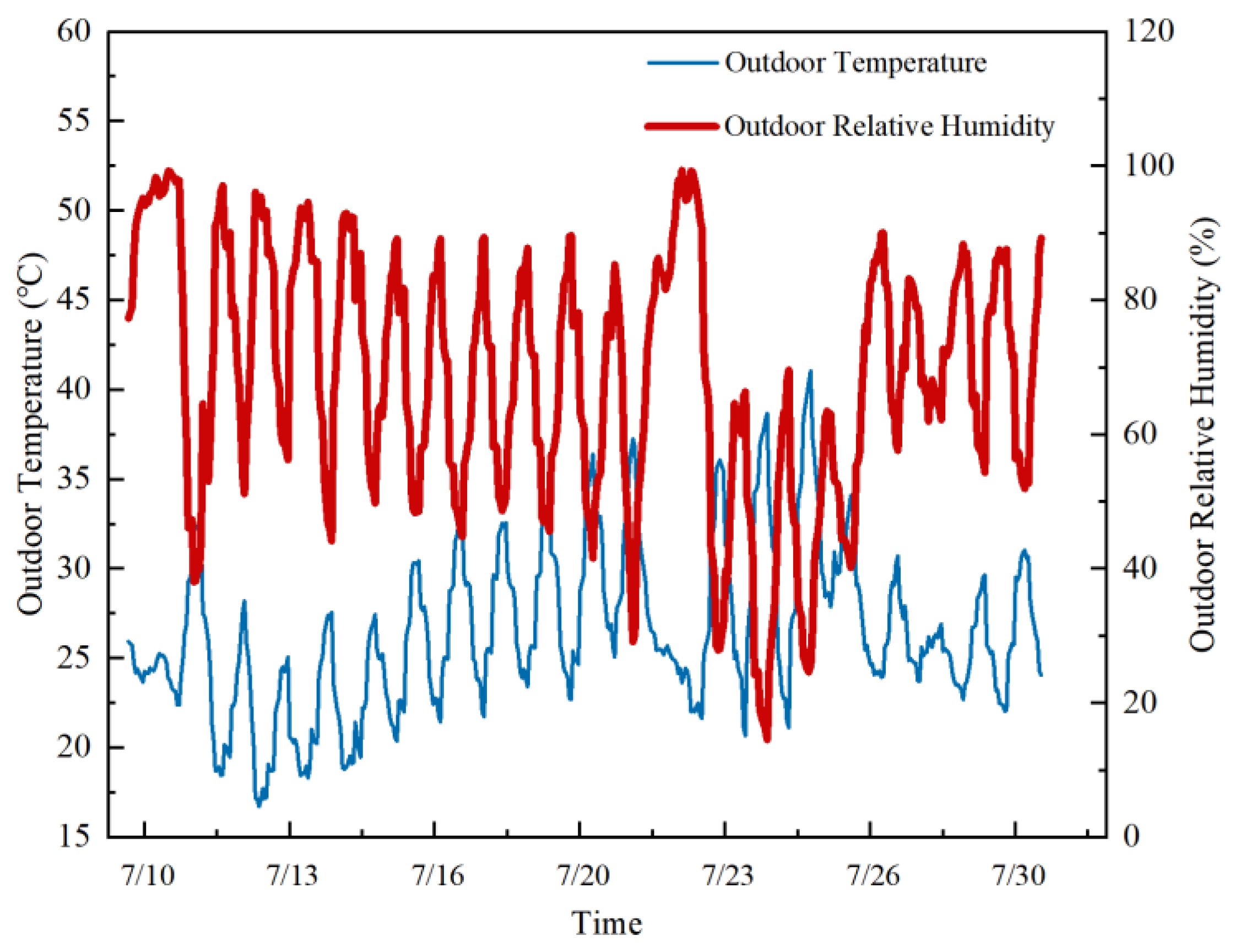

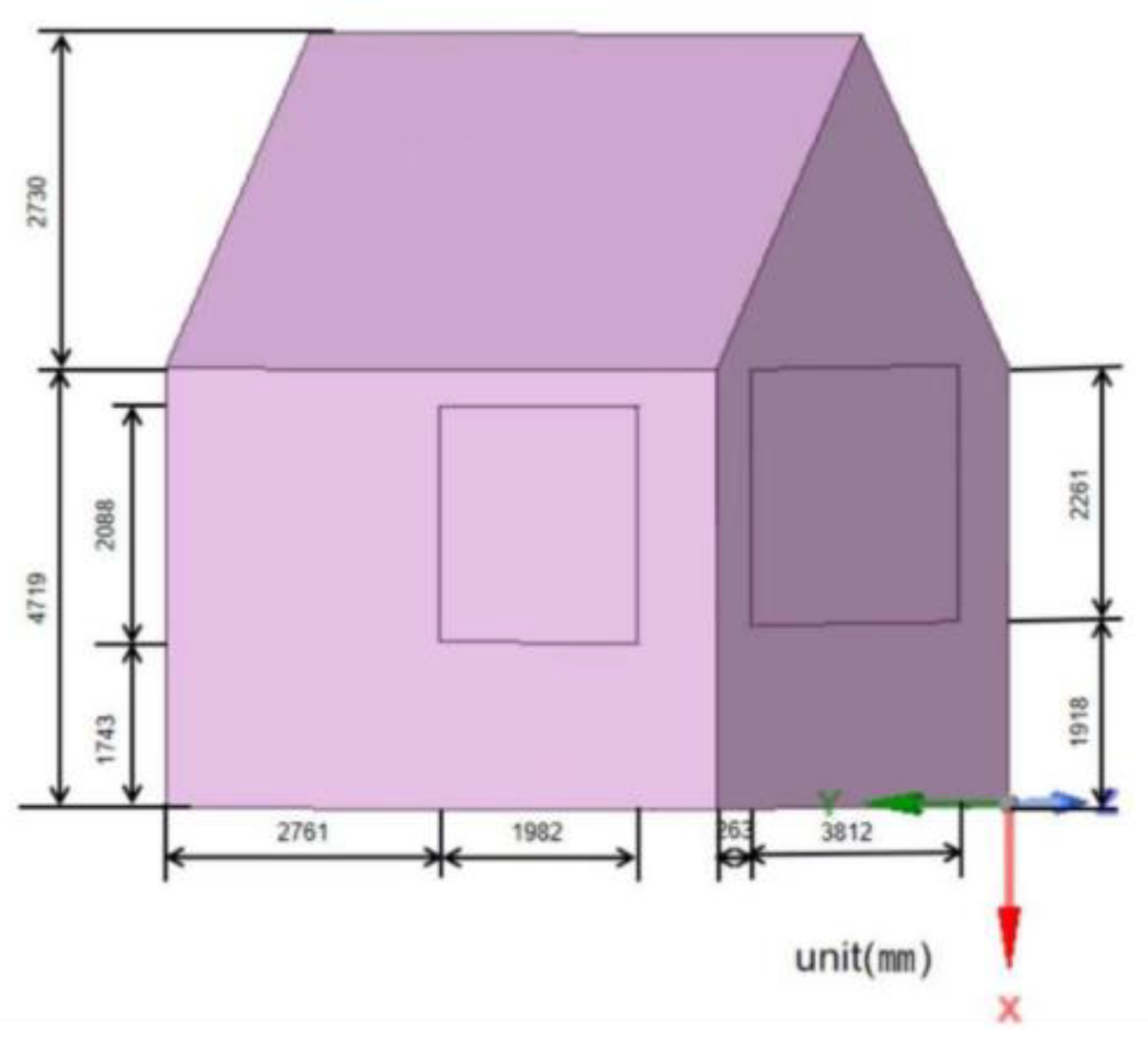
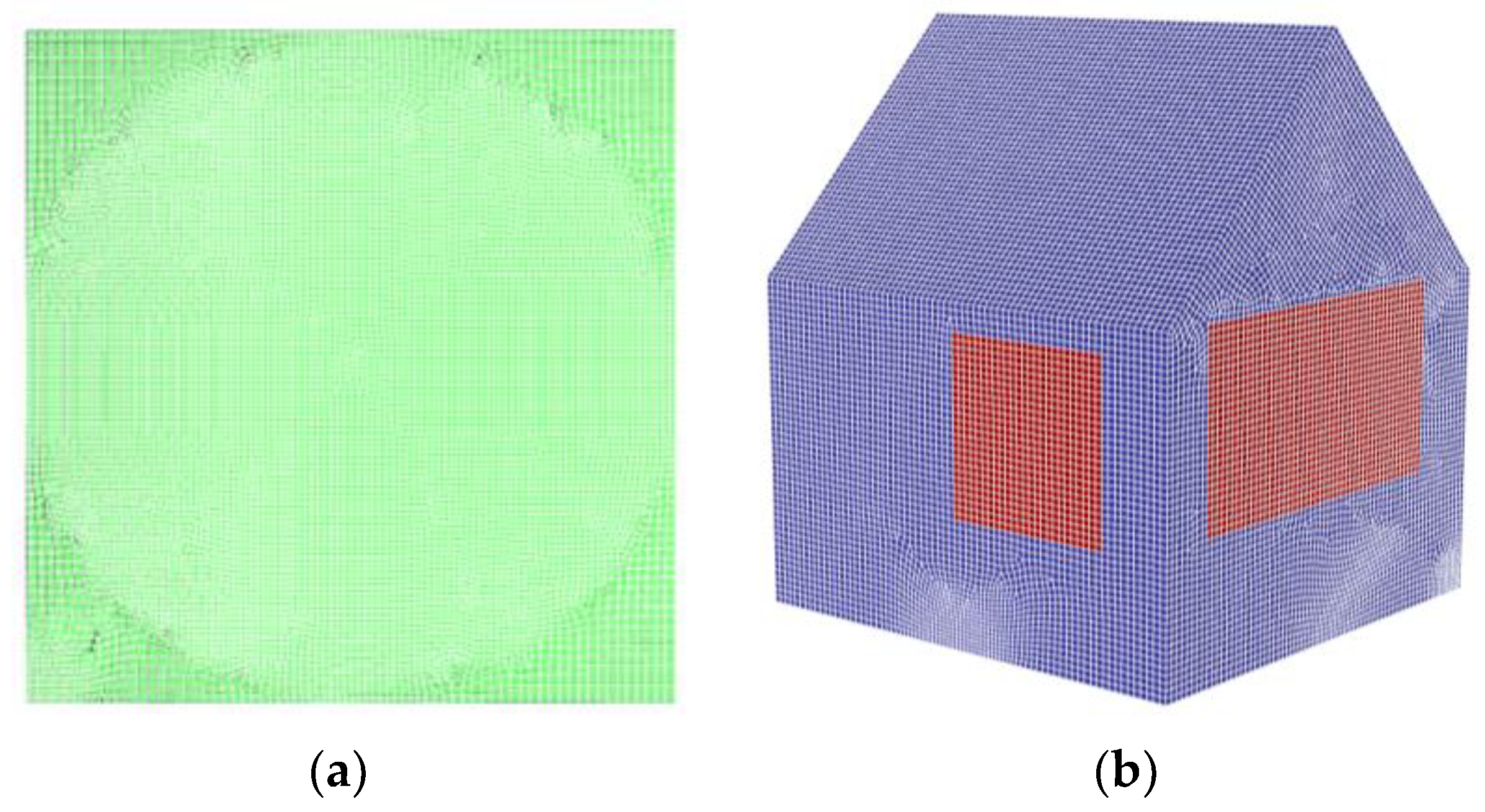
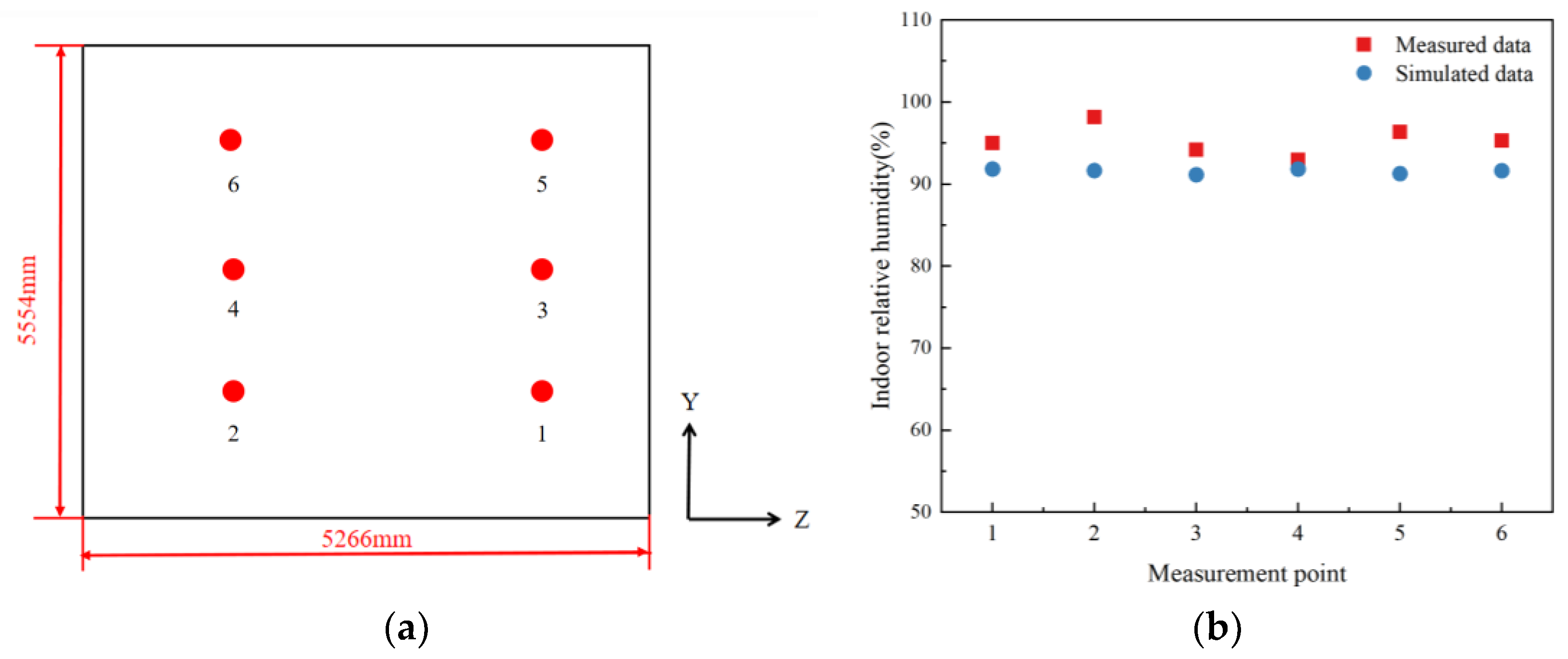
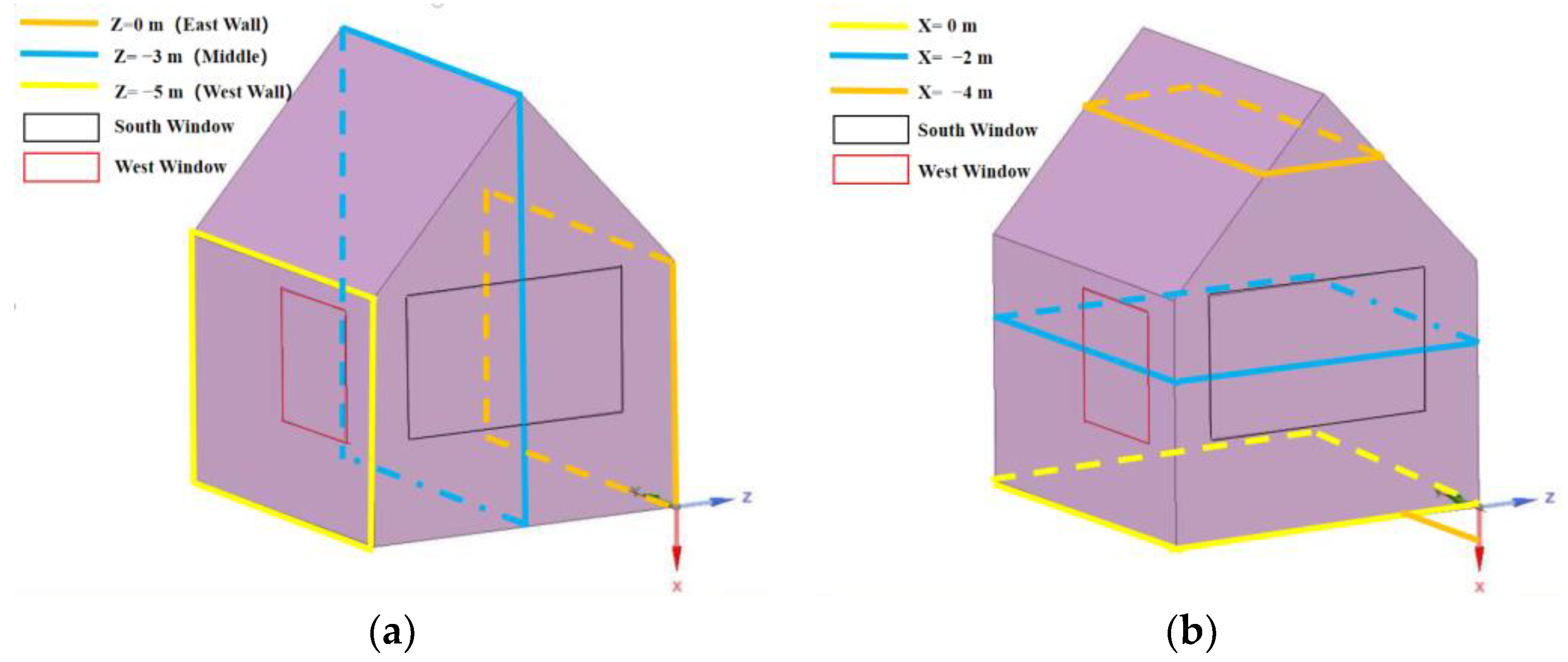

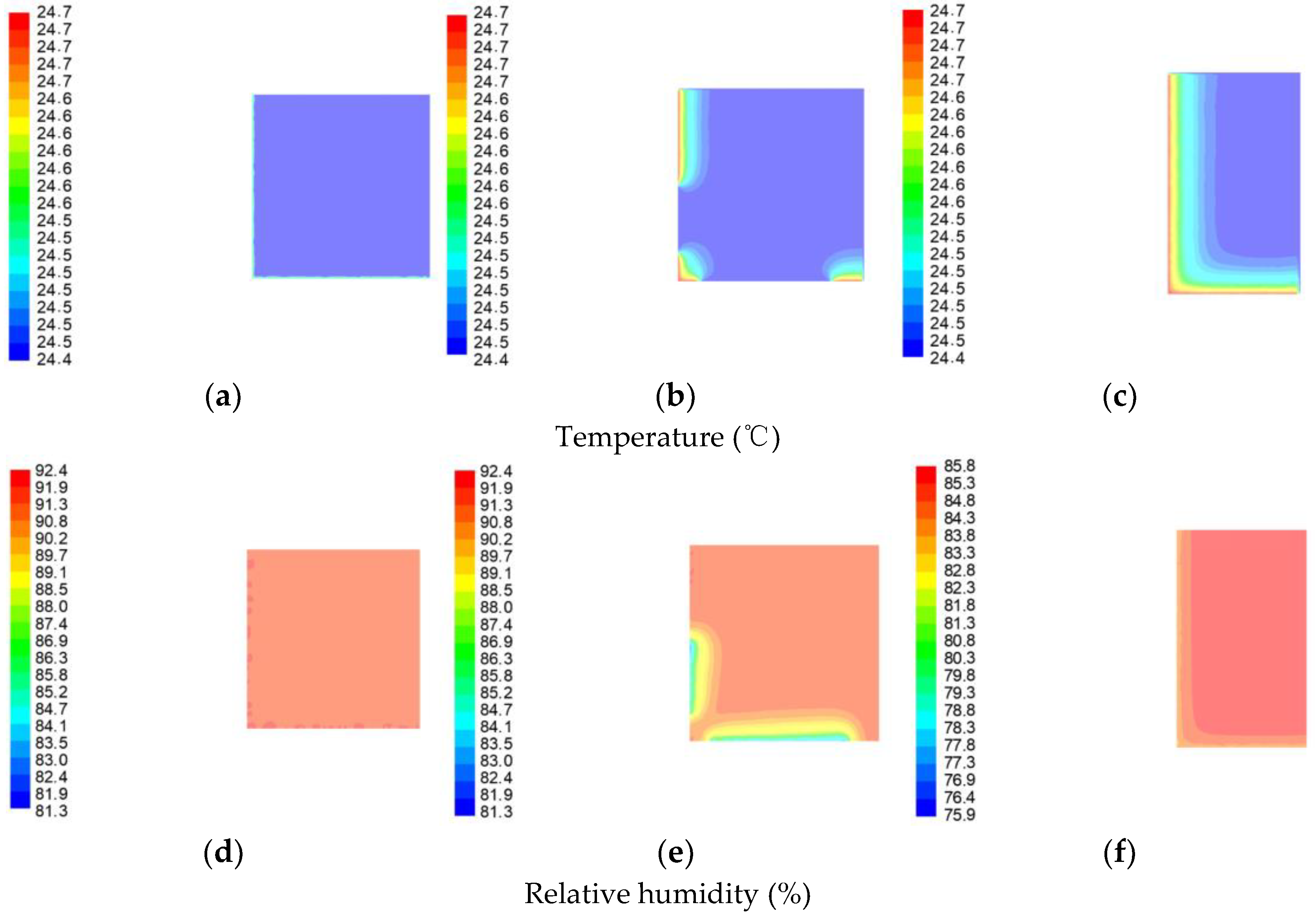



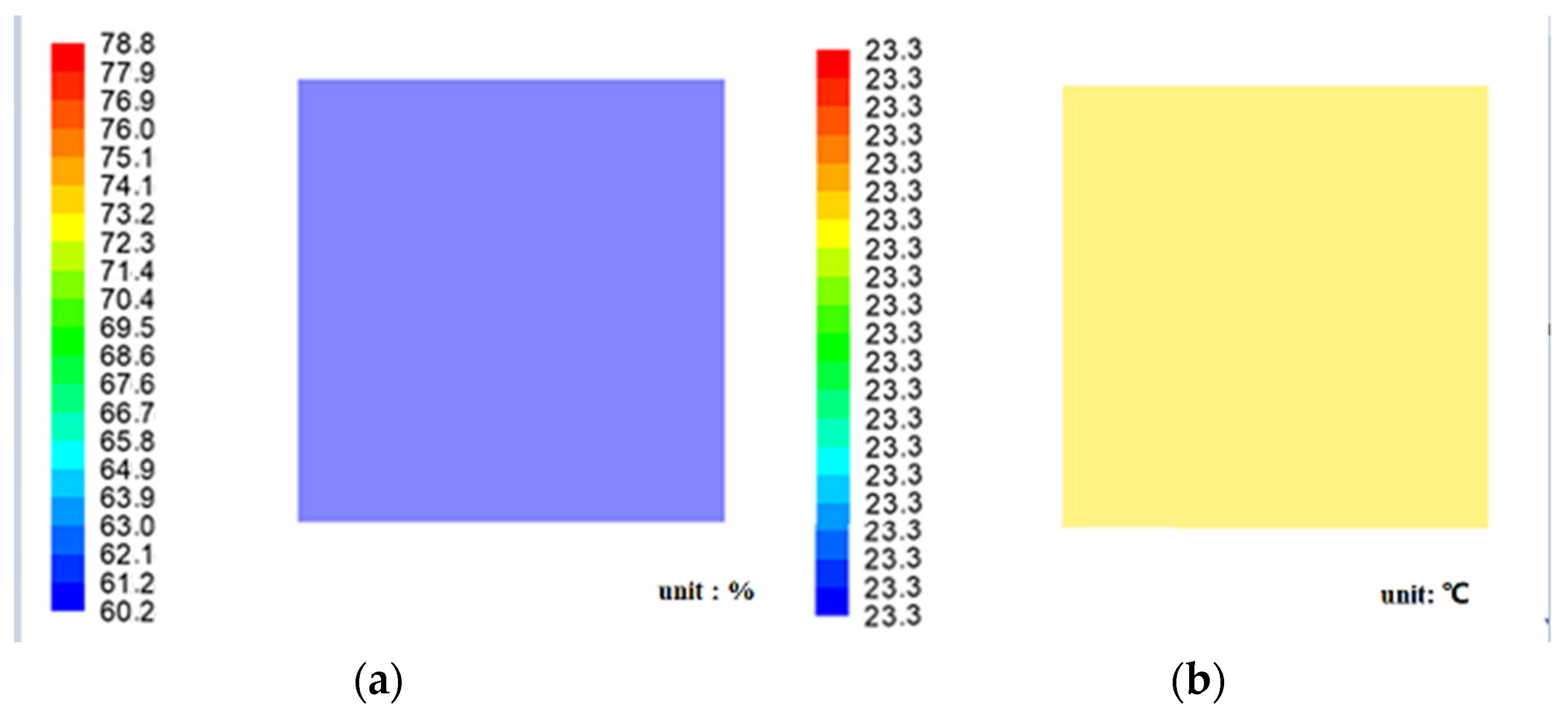
| Building Envelope Types | Structural Composition | Environmental Functions |
|---|---|---|
| Roof | Tiles, tile mud, bottom tile, clip ridge ash, gray back, watch board, etc. | It can buffer the external temperature, heat insulation, heat preservation, windproof, rainproof, and so on. |
| Interior wall | Papering, gold cladding earthen wall, oil-painting ground layer, etc. | Built of grey brick, the exterior paint is made of water-resistant properties. It has the functions of being windproof, waterproof, and blocking solar radiation. It can buffer the change in external temperature, has thermal insulation performance, and blocks indoor and outdoor air circulation. |
| Exterior wall | Wall brick masonry, plaster layer, and bonding material | |
| Doors and windows | Embrace frame, Geshan door, glass, threshold, metal components, finish coat layer, and internal papering | The doors and windows composed of wood and glass can reduce indoor and outdoor ventilation and buffer temperature changes to a certain extent. |
| Interior flooring | There is a kang under the indoor brick of the building. | The indoor ground plays an important role in isolating underground moisture; the indoor ground of the kang system has the effect of heat conduction. |
| Roof | Tiles, tile mud, bottom tile, clip ridge ash, gray back, watch board, etc. | It can buffer the external temperature, heat insulation, heat preservation, windproof, rainproof, and so on. |
| Name | L/mm | W/mm | H/mm |
|---|---|---|---|
| Building body | 5366 | 5554 | 6816 |
| Window 1 (west side) | 1982 | 2088 | --- |
| Window 2 (south side) | 3812 | 2261 | --- |
| Floor tiles/pc | 550 | 400 | 53 |
| 517 | 510 | 53 |
| Designation | ) | |
|---|---|---|
| Ground | 1.50 | |
| Wall | North–South Wall | 0.68 |
| East–West Wall | 0.84 | |
| Average | 0.76 | |
| Environment | Temperature/°C | Relative Humidity/% | Moisture Content/g/kgdry air | Water Vapor Partial Pressure/kPa | Mass Fraction of Water Vapor/% | |
|---|---|---|---|---|---|---|
| Indoor | Center | 24.7 | 75 | 14.67 | 2.3347 | 0.0145 |
| Ground | 23.3 | 81.5 | 15.97 | 2.5371 | 0.0157 | |
| Interior wall | 24.7 | 92 | 18.09 | 2.8639 | 0.0167 | |
| Grid Classification Levels | Grid Size/m | Number of Meshes/Pieces | Ground Average Temperature/°C | Ground Average Relative Humidity/% |
|---|---|---|---|---|
| 1 | 0.05 | 17,315,932 | 23.3 | 79.69638 |
| 2 | 0.06 | 1,594,340 | 23.3 | 79.63364 |
| 3 | 0.07 | 1,085,324 | 23.3 | 79.66715 |
| 4 | 0.08 | 779,490 | 23.3 | 79.60327 |
| 5 | 0.09 | 583,620 | 23.3 | 79.59776 |
| Dependent Variable | Indoor Relative Humidity |
|---|---|
| Correlation coefficient with outdoor environmental humidity | 0.486 |
| Correlation coefficient with soil moisture | 0.995 |
| Correlation coefficient with wall moisture | 0.993 |
Disclaimer/Publisher’s Note: The statements, opinions and data contained in all publications are solely those of the individual author(s) and contributor(s) and not of MDPI and/or the editor(s). MDPI and/or the editor(s) disclaim responsibility for any injury to people or property resulting from any ideas, methods, instructions or products referred to in the content. |
© 2023 by the authors. Licensee MDPI, Basel, Switzerland. This article is an open access article distributed under the terms and conditions of the Creative Commons Attribution (CC BY) license (https://creativecommons.org/licenses/by/4.0/).
Share and Cite
Liu, F.; Zhang, X.; Zeng, J.; Li, Y.; Wang, G. The Numerical Study on Indoor Heat and Moisture Transfer Characteristics of an Ancient Palace Building in Beijing. Processes 2023, 11, 1900. https://doi.org/10.3390/pr11071900
Liu F, Zhang X, Zeng J, Li Y, Wang G. The Numerical Study on Indoor Heat and Moisture Transfer Characteristics of an Ancient Palace Building in Beijing. Processes. 2023; 11(7):1900. https://doi.org/10.3390/pr11071900
Chicago/Turabian StyleLiu, Fang, Xiaofen Zhang, Jiarui Zeng, Yafei Li, and Gang Wang. 2023. "The Numerical Study on Indoor Heat and Moisture Transfer Characteristics of an Ancient Palace Building in Beijing" Processes 11, no. 7: 1900. https://doi.org/10.3390/pr11071900
APA StyleLiu, F., Zhang, X., Zeng, J., Li, Y., & Wang, G. (2023). The Numerical Study on Indoor Heat and Moisture Transfer Characteristics of an Ancient Palace Building in Beijing. Processes, 11(7), 1900. https://doi.org/10.3390/pr11071900








